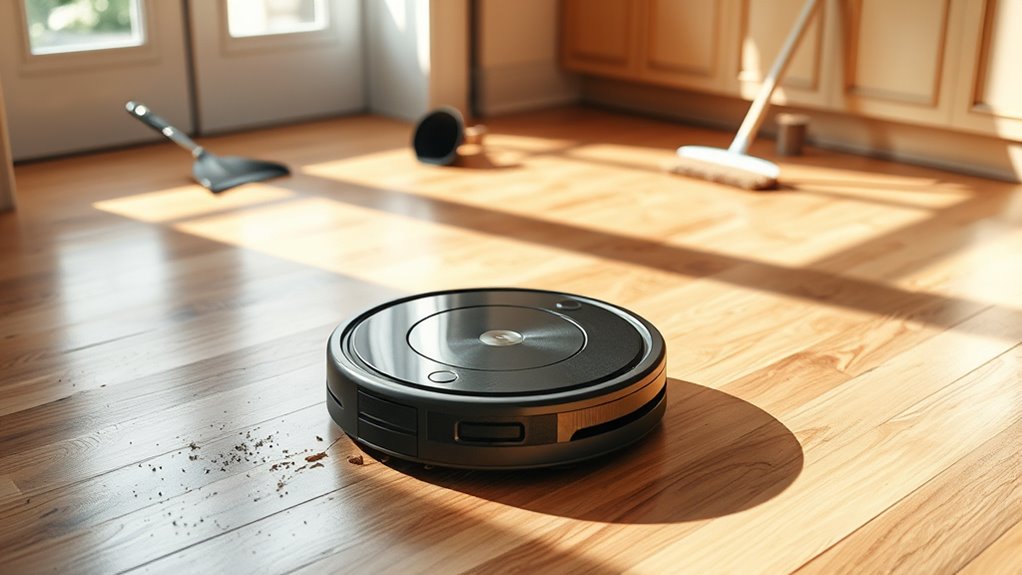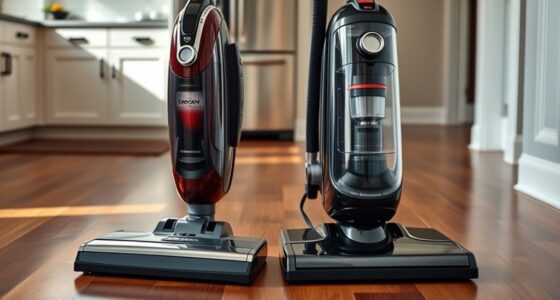Robot vacuums can be a great cleaning solution, especially for busy lifestyles. They offer automated schedules, can access tight spaces, and often feature HEPA filters for better air quality. However, they do have drawbacks. They may miss corners, have limited battery life, and struggle with tough messes or deep carpets. These factors affect their overall cleaning effectiveness. Want to know more about their advantages and limitations? There’s plenty more to explore!
Key Takeaways
- Robot vacuums excel at automated cleaning and can efficiently reach tight spaces under furniture.
- They may struggle with corners and edges, requiring additional manual cleaning.
- Battery life is limited, often leading to interruptions in cleaning sessions.
- Cleaning performance can be inadequate on carpets and larger debris without pre-cleaning.
- While they offer convenience, their effectiveness and maintenance costs may not justify the higher initial investment for some users.
Advantages of Robot Vacuums
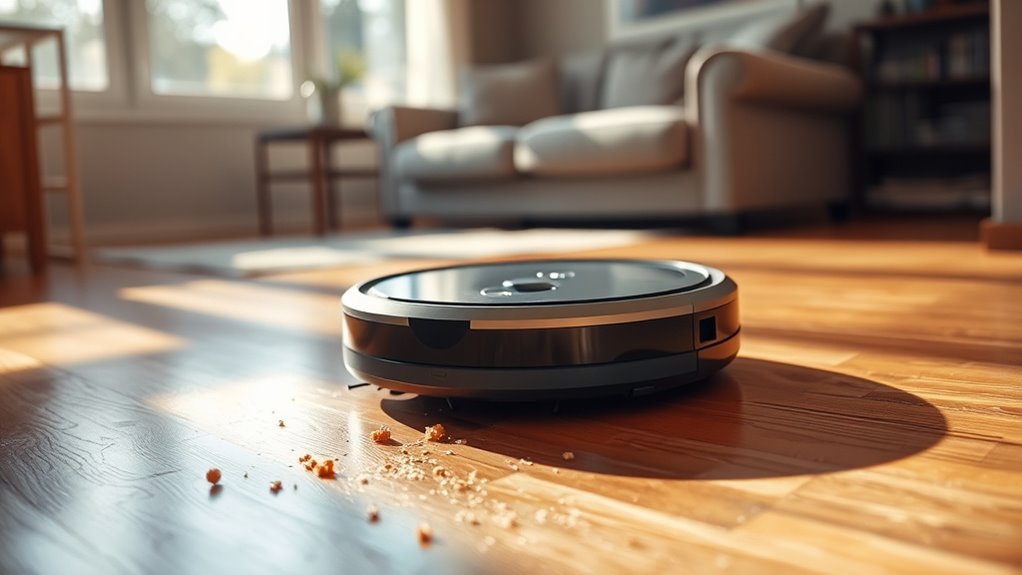
Robot vacuums bring several advantages that make them a popular choice for modern households. With their ability to create a cleaning schedule, you can set them to tidy up while you’re away, ensuring a consistently clean home without lifting a finger.
These robot vacuum cleaners excel at picking up dust in tight spaces and beneath furniture where traditional vacuums struggle. Many smart vacuums even combine vacuuming and mopping, giving you versatile cleaning options. Additionally, HEPA filter technology allows them to effectively eliminate allergens, contributing to improved air quality in your home. Their advanced sensors also enhance navigation, ensuring that they clean efficiently without missing spots. Moreover, using a robot vacuum can help reduce feelings of burnout recovery by lessening the physical demands of maintaining a clean home. Furthermore, models equipped with smart capabilities can integrate with your home system for remote operation, making cleaning even more convenient.
Plus, equipped with HEPA filters, they effectively capture fine dust and allergens, improving your indoor air quality. Some models feature self-emptying capabilities, greatly reducing your maintenance efforts. Additionally, using a robot vacuum can help maintain optimal air quality by reducing allergens, which is beneficial for allergy sufferers.
Disadvantages of Robot Vacuums
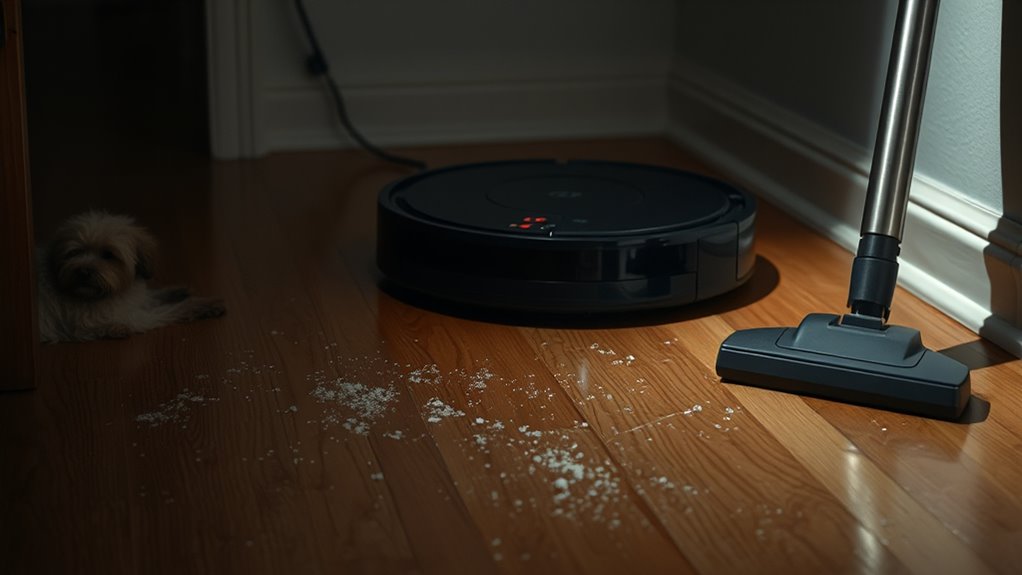
While robot vacuums offer convenience, they come with notable drawbacks that can impact your cleaning experience.
One of the main disadvantages of robot vacuums is their cleaning performance; they often miss corners and edges, requiring you to manually clean those areas. Additionally, many models have limited battery life, leading to frequent recharging, especially in larger spaces. In fact, some models may only operate for average battery life of about 60 to 90 minutes before needing a recharge. This limited operational time can be particularly frustrating in homes with high traffic areas where more frequent cleaning is necessary. Regular maintenance, like cleaning stovepipes, is also crucial for optimal performance. Moreover, many robot vacuums lack features like high suction power, which can further hinder their ability to effectively tackle tougher messes.
The small dirt bins can fill up quickly, particularly in homes with pets, creating a maintenance hassle. Furthermore, navigation issues can cause the vacuum to get stuck under furniture or tangled in cords, disrupting its cleaning routine. In comparison to traditional models, some robot vacuums may struggle with suction power and overall cleaning efficiency in more challenging environments.
Performance Limitations
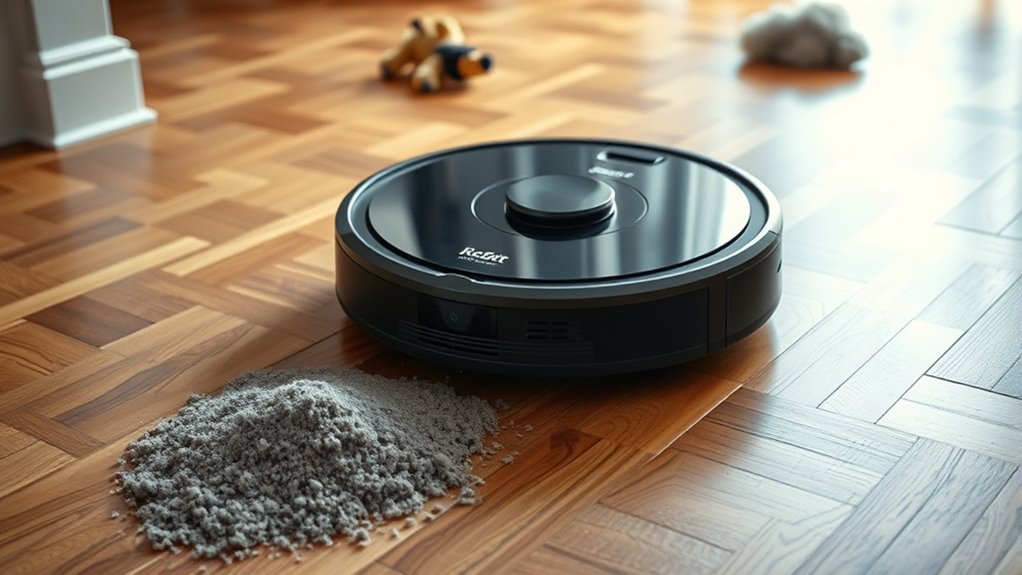
Cleaning performance can be a significant concern with robot vacuums.
These devices often face performance limitations, particularly when cleaning carpets. You might find that they miss corners and edges, leaving spots that need manual attention. They can also struggle with obstacles like low-height furniture and door thresholds, which can interrupt a cleaning session. Additionally, if you have deep carpets or larger debris, some models may not perform effectively. Often, you may need to pre-clean areas to remove obstacles, limiting their effectiveness in cluttered spaces. Moreover, the contrast ratios of robot vacuums may not match the performance of traditional vacuum cleaners in capturing fine dust and dirt. It’s important to note that the potential side effects of using certain cleaning agents may also affect the performance of these devices on various surfaces. Furthermore, the effectiveness of cleaning can vary based on the mattress toppers used in the home, as they may trap dust and debris that robot vacuums struggle to extract. Additionally, the maintenance costs associated with robotic cleaners can be higher than anticipated, impacting overall value over time. Regular grooming of pets can also help reduce the amount of pet hair that accumulates on surfaces, making it easier for robot vacuums to maintain cleanliness.
Battery and Charging Issues
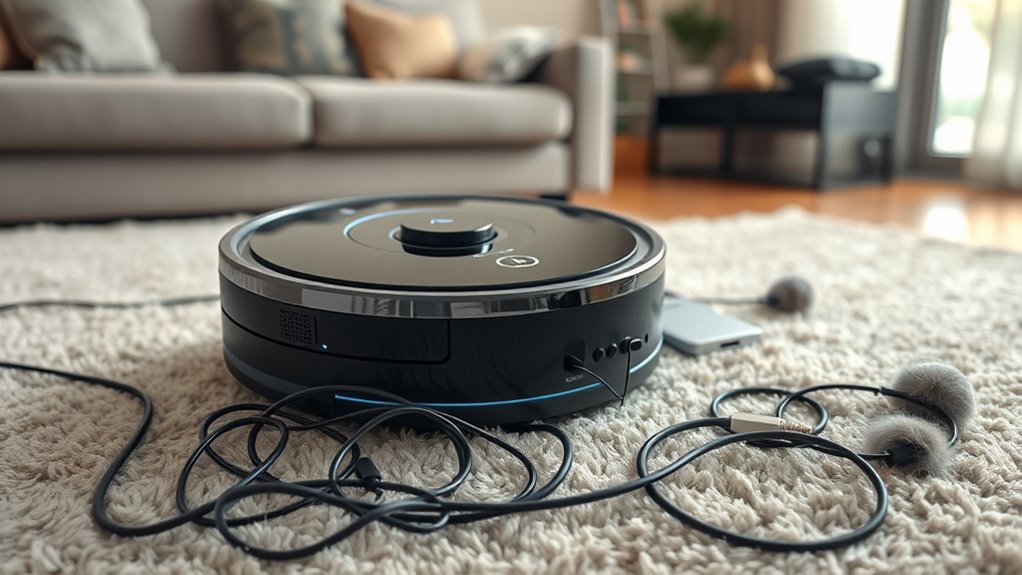
When considering a robot vacuum, battery and charging issues can greatly impact your cleaning experience. Most models offer limited battery life, usually between 60 to 120 minutes, which may not cover larger cleaning areas in one go. Additionally, the importance of research before investing in a robot vacuum can help you choose one with optimal battery performance.
As the battery ages, you might notice a performance decline, reducing your vacuum’s runtime. Fortunately, many vacuums come with auto-return charging features, allowing them to dock and recharge independently when their battery levels are low. Additionally, implementing solar energy solutions for charging can enhance the sustainability of your cleaning routine. Moreover, utilizing energy-efficient systems can lead to a decrease in overall energy demand, contributing to a more eco-friendly approach. Moreover, integrating wind energy innovations into your home can further reduce energy costs and support renewable energy use.
However, for larger spaces, you may still face mid-session charging interruptions, extending your overall cleaning time. Advanced models like DEEBOTs stand out with impressive battery life, achieving up to 320 minutes on a single charge, making them more suitable for extensive cleaning tasks. Additionally, ensuring the correct refrigerant levels can improve the efficiency of your cleaning routine by extending the lifespan of the vacuum’s battery.
Noise and Maintenance Challenges
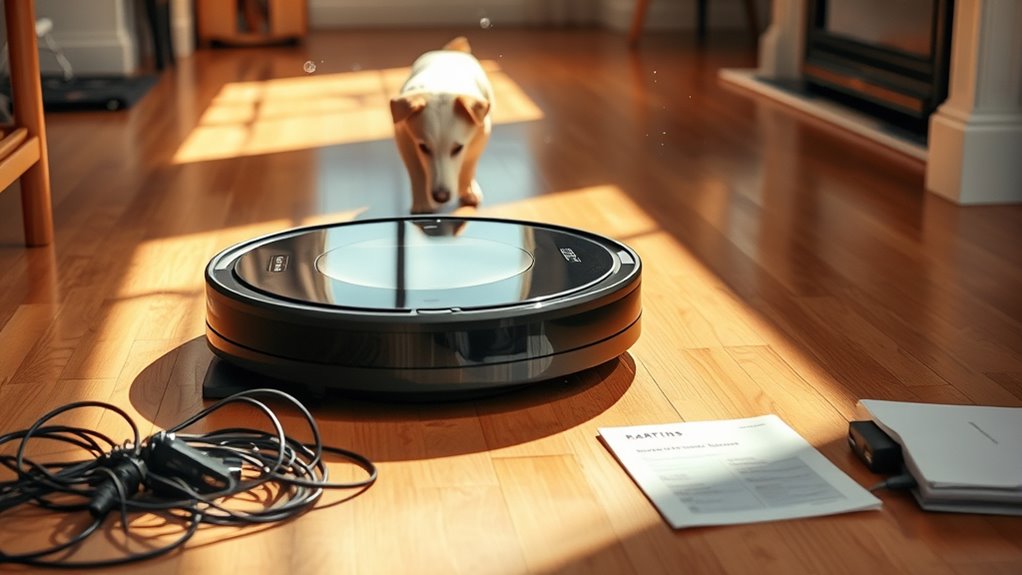
Battery life is just one aspect of robot vacuums that can affect your overall satisfaction; noise and maintenance challenges also play significant roles.
While robot vacuums generally produce noise levels comparable to traditional vacuums, this can become disruptive, especially during long cleaning sessions. Some models have an automatic emptying feature that sounds like a jet, making it even more noticeable. Additionally, suction power varies among models, which may impact cleaning efficiency. Regular cleaning is essential for optimal performance, as dust and debris accumulation can hinder effectiveness. Regular maintenance is essential for ideal performance, including cleaning filters and frequently emptying small dustbins—especially in pet-friendly homes. If these dustbins aren’t managed properly, hygiene concerns may arise. Additionally, frequent promotions on replacement parts can help ensure that your robot vacuum remains in top condition without breaking the bank. Moreover, understanding cookie categories can enhance your overall experience with purchasing decisions related to robot vacuums.
Cost and Value Considerations
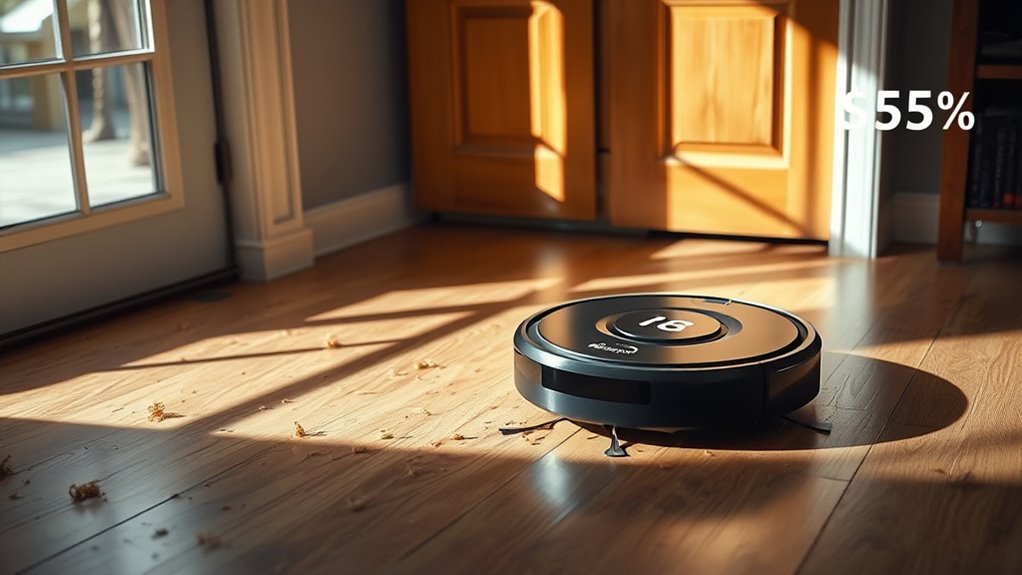
When you consider buying a robot vacuum, the initial investment can be quite steep, ranging from about $250 to over $1,000.
While the convenience of features like scheduled cleaning might seem appealing, you should weigh whether those benefits truly save you money in the long run compared to traditional vacuums.
Additionally, keep in mind that ongoing maintenance costs can add up, potentially affecting the overall value of your purchase.
Initial Investment Analysis
While many people appreciate the convenience of robot vacuums, the initial investment can be a significant consideration.
Prices for a robot vacuum cleaner typically range from $250 for basic models to over $1,000 for high-end versions, like the iRobot Roomba j9+ Combo. You’ll also need to factor in maintenance costs, as consumables like filters and bags may increase your overall expenditure.
Many users find that traditional vacuums offer better cleaning efficiency, especially for those with specific cleaning needs. Although the time saved can provide long-term value, it’s essential to assess whether the cleaning performance justifies the high initial investment.
For budget-conscious consumers, a traditional vacuum might be a more practical choice.
Long-Term Cost Savings
Although the initial cost of a robot vacuum might seem steep, many users find that the long-term savings and convenience it offers often outweigh the upfront investment.
Here are some key factors to evaluate regarding long-term cost savings:
- Time saved: Less frequent cleaning means you can focus on other tasks.
- Reduced maintenance time: Models with self-emptying features require minimal upkeep.
- Total cost of ownership: Factor in both the initial cost and ongoing expenses, like replacement parts.
- Automated solution: Regular cleaning can lead to a cleaner home with less effort.
In busy households, these advantages can justify the investment, making a robot vacuum a smart choice for long-term value.
Value vs. Traditional Vacuums
As you weigh the decision between a robot vacuum and a traditional model, consider the stark differences in cost and value.
Robot vacuums typically range from $250 to over $1,000, making them a significant upfront investment compared to traditional vacuums, which are often much cheaper.
While a robot vacuum saves you time by automating cleaning tasks, that time saved mightn’t justify their high cost, especially on a budget.
Additionally, maintenance costs can add up; regular upkeep like emptying dustbins and replacing filters tends to be pricier than for traditional vacuums.
Comparison With Traditional Cleaning Methods
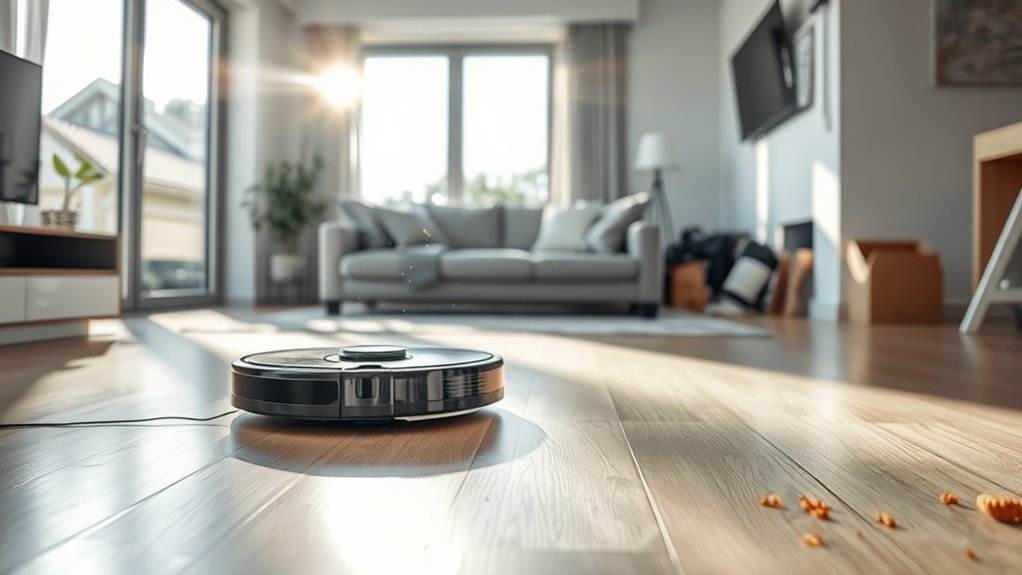
When you compare robot vacuums to traditional cleaning methods, you’ll notice differences in cleaning efficiency and convenience.
While robot vacuums save you time by automating the process, they often miss spots and may not clean as deeply as a traditional vacuum.
Understanding these trade-offs can help you choose the best option for your cleaning needs.
Cleaning Efficiency Comparison
Cleaning efficiency varies considerably between robot vacuums and traditional methods.
While robotic vacuum cleaners excel on hard floors and low-pile carpets, they often fall short with deep cleaning carpets.
Here are some key points to contemplate:
- Robot vacuums typically take longer to navigate spaces methodically.
- They require pre-cleaning setup, like decluttering, to optimize performance.
- Traditional vacuuming generally achieves a higher cleanliness standard, adapting to specific needs.
- The efficiency of robot vacuums varies by model, with high-end options performing better.
Convenience and Time Savings
While traditional cleaning methods often require a significant time commitment, robot vacuums offer a game-changing alternative that automates the process.
With robotic vacuum cleaners, you can schedule cleaning sessions, allowing them to tackle dust and debris while you’re away. This means you can save time for other activities, unlike manual cleaning, which demands your attention.
Many models operate quietly, ensuring your clean floors stay undisturbed even during work hours or while you’re relaxing. Plus, they effortlessly reach under furniture and into tight spaces, areas often neglected during traditional vacuuming.
However, keep in mind that their smaller dirt bins require frequent emptying, unlike traditional vacuums that can handle larger loads in one go.
Frequently Asked Questions
Do Robot Vacuums Actually Clean Well?
Imagine a tiny, tireless helper gliding across your floors, picking up dust and debris.
Do robot vacuums actually clean well? They can tackle carpets and hard surfaces, but they may miss those pesky crumbs tucked in corners.
While their HEPA filters help with allergens, they mightn’t reach every nook and cranny.
What Are the Disadvantages of a Robot Vacuum Cleaner?
When considering a robot vacuum, you’ll encounter several disadvantages.
First, they often require you to clear clutter and cords beforehand to avoid jams. You might find yourself emptying their small dirt bins frequently, especially if you have pets.
Additionally, they can struggle with thick carpets and miss debris in corners.
Battery life can also limit their cleaning range, leading to interruptions, and high prices mightn’t justify the results you expect.
Is a Robot Vacuum Cleaner Worth It?
Imagine a tireless little helper, whisking away dust while you sip coffee or tackle work.
A robot vacuum can be worth it if you value convenience and time savings. However, you’ll need to weigh its limitations against your cleaning needs.
It won’t replace deep cleaning, especially on carpets, and you’ll find yourself emptying its dustbin often.
If you’re ready to embrace its quirks, it might just be the perfect addition to your home.
Is Self Cleaning Worth It on a Robot Vacuum?
When considering a self-cleaning robot vacuum, you should weigh the convenience against the cost.
If you’ve got pets or a busy lifestyle, the ability to go up to 60 days without emptying the bin can save you significant time and effort.
The advanced features often prevent tangling and improve cleaning performance.
Ultimately, investing in a self-cleaning model might be worth it for the long-term savings and hassle-free maintenance it offers.
Conclusion
In the garden of cleaning tools, robot vacuums are like diligent little bees, buzzing around to gather dust and debris. They’ve got their strengths, flitting through your home with ease, but sometimes they miss the hidden corners and stubborn stains, much like bees overlooking the flowers in the shadows. While they’re a sweet addition to your routine, don’t forget to tend to the weeds yourself. Balance is key, ensuring every nook is tended to for a truly clean space.
